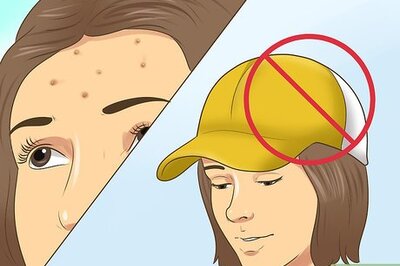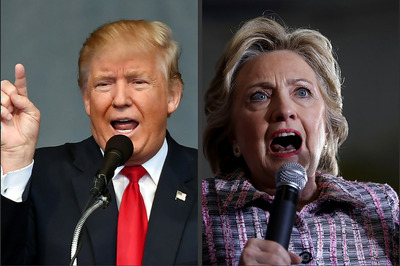
views
Even as India’s active Covid-19 cases are witnessing a significant slide and the recovery rate has escalated, parts of the country such as Delhi have seen a worrying spike of the infection.
In an exclusive interview with CNN-News18, Dr Randeep Guleria, director of AIIMS and member of the national task force on Covid-19 management, explained the varied pictures of the pandemic emerging from different parts of the country, what challenges lie ahead, the treatment mechanisms being used and their efficacy including plasma therapy and remdesivir, and when the common man can expect a shot in the arm with an effective vaccine.
You have spoken about multiple peaks in India. What does that mean? Is Delhi seeing its third peak then? Is Kerala seeing its second peak?
Different parts of the country will behave differently and we can’t generalise peaks across the country. Different states, different regions will behave differently. We have had a peak in Mumbai and Maharashtra early on and now there is a decline in cases there. This will continue to happen. As far as Delhi is concerned, we can’t say that the peak was over for us to say there is a third peak. It had not come down to the levels for us to say that the second peak was over. Delhi is seeing an escalation of the ongoing second peak. It is premature to say that this is the third peak in Delhi.
What is happening in Delhi now? Why are we seeing such a spike?
There are multiple factors. Most importantly human behaviour. There is Covid fatigue in Delhi. In Delhi and other metropolitan cities if people don’t follow social distancing and people don’t wear masks then any event can lead to a spread. One person not taking the precautions can lead to a superspreading event. Other factors are also contributing to the increase in cases. One is the weather. We know that respiratory viruses spike in winter months; we have seen a drop in temperature in Delhi. There are higher chances of the virus surviving in outdoor air and people tend to crowd indoors during winters. The third factor is air pollution which is also contributing to the spike.
What about Kerala? What went wrong for the state? We saw a spike post Onam. The state was doing very well otherwise.
When there is a festive season or any event that can lead to people crowding together and there are people who are not wearing masks, there will be a risk of subsequent increase in cases in 2-3 weeks. That happened in Kerala. It can happen in other states also. I think we have to look at what is happening globally also. Look at Europe, look at the West. It is a classic example of people not following the norms. There is a spike in cases there. But compare this with Vietnam, South Korea, Taiwan and even New Zealand. Because people have been more behaviour conscious, these countries have not seen a resurgence, their economies are getting back up, their lives are getting back to normal, and they have been able to manage Covid well.
You spoke of superspreading events, crowds gathering. Look at the political rallies in Bihar. Do they worry you? Are you wary that in the days to come this could mean more cases in Bihar?
This is a huge cause of concern as we have seen, in these rallies, there is no physical distancing and no one is wearing masks. There is a concern that in Bihar there will be an increase in cases over the next two weeks. We also have the festive season and Chhath Puja is also coming up, and I would request everyone to continue to follow the norms.
The official figure for Covid-19 cases in India is over 80 lakh. Would you say that the real figure is about three times that?
That is possible because data suggests that 40% of individuals may be asymptomatic. This means that these are the people who were infected, recovered and did not even know. This is what the sero survey is also showing. The actual number of cases would be much higher than what we are seeing. A large number of people would never have gotten tested. We should look at the infection-mortality rate. Keeping this in perspective then our death rate would come down much more if we count all of these people who were never tested because they were asymptomatic, if we do a sero survey and find out how many people had the infection but were not counted as patients.
Is there inadvertent under-reporting of deaths in India?
No. That is not happening. All hospitals are actually taking in all patients after a Covid test nowadays. This actually means that there have been more recoveries also. The diagnosis of a severe Covid patient is unlikely to be missed.
There is a study that says Mumbai and parts of Maharashtra would be reaching herd immunity by 2020. Would you agree?
There are two important things. Mumbai is a very large city. There are certain areas in Mumbai where there are large populations. It is likely that herd immunity would have happened in those areas. But there are certain areas that are more scattered and it is difficult to say if there has been herd immunity there. In certain pockets, it is likely that herd immunity has developed. But to say that it has developed in the entire city would require more data for that claim.
Long Covid is a huge concern. As a pulmonologist, what is it that you are seeing in patients who have recovered from Covid-19?
Long Covid is a problem. We are realising this now. We have a good recovery rate and we are now seeing patients who have come out of this. Two-thirds of patients have some problems of long Covid. A majority of them have symptoms that are mild and will resolve within 6-8 weeks. Headache, body ache, pain in the calves, tiredness are the most common symptoms. There are recovered patients of Covid who continue to suffer from brain fog. Less than 5% of patients have significant damage after Covid-19. I am seeing patients with lung fibrosis and scarring of the lung tissue in pneumonia patients. Some patients need oxygen even after recovery because of this. This is a big problem.
How badly is rural India infected?
The pandemic will peak in different places at different times. That is also true for rural India. Initially the surge was in metropolitan cities. Now the pandemic has moved to smaller cities and rural areas. The good thing is that in rural India, the crowding is not that much, so there is physical distancing. Surge in cases in rural India may not happen at such rapid pace like it happened in cities.
Is the curve flattening in India now, if you simply consider the national picture ? Are you satisfied with the decline in growth rate of cases?
The picture is satisfying simply because our numbers are coming down. My only concern is that with the ongoing festive season and the kind of crowds that we are seeing, there could be a resurgence. It is important to sustain the downward trend for the next 2-3 months; then we can say we have been successful in getting over the pandemic.
Is lockdown an option if cases spike? Can we go in for a lockdown like the UK?
You have to balance out lives vs livelihood. We will have to look at regional lockdowns, local containment zones will have to be identified. There has to be aggressive contact tracing, treating and isolating patients. We did that very aggressively in the beginning but there is Covid fatigue even among the healthcare workers and we need to reenergise ourselves.
What about the BCG vaccine? A small study is showing that it is protecting adults. How can the national task force, of which you are a member, cash in on this?
Of course, we can take it forward. There are other studies also. A controversial one from Israel shows that the BCG vaccine is not helping. One study from Europe has shown that those who were getting vaccinated developed less Covid infection. So we need to look at the data. One of the theories is that in a country like India we all get BCG vaccines at birth and that is why there is less infection. Can a booster dose boost the immune system? There is data to show that BCG protects against viral infections. It is plausible that BCG could be able to protect the elderly and higher-risk groups.
What according to you would be the biggest challenge before India when we have a vaccine?
Once we have a vaccine, which is approved, we have to work on a strategy on how to distribute it in different parts of the country so that those who we have prioritised get it immediately. Maintaining the cold chain, having adequate syringes, adequate needles and being able to deliver it to the remotest part of the country in a seamless manner is the biggest challenge. The second challenge is that there is more than one vaccine candidate that is being studied. So if we have a vaccine that comes out later and is seen to be more effective than the first one, how do we position it? How do we do a course correction? How to then decide who needs vaccine A and who needs vaccine B? A lot of decisions need to be taken as we go along.
Can any inoculation drive be complete if we are not vaccinating our children? When will vaccine trials on children start?
Whenever we do trials, we do it on healthy adults. Then we do it on children and the elderly. We will have to look at vaccinating children at some point in time. Luckily children are getting mild Covid, but they still can transmit. On the priority list this will not be our top priority.
Vaccine will have about 50% efficacy. This means that we have to continue to follow social-distancing norms and wearing masks till the end of the pandemic.
Correct. Vaccine is not a magic bullet. Covid will not vanish with vaccination. Vaccination will help us deliver herd immunity rapidly. It will help us break the chain of transmission and fewer and fewer people will get infected, but it will not be zero. We will continue to need to do what we are doing now.
Moderna’s vaccine requires storage at -20 degrees, Pfizer’s at -70 degrees. Will these vaccines be practical for a country like India?
We will see how we can position these vaccines. We may not be able to give some vaccines, which require -70 or -80 degrees, in smaller towns and rural areas. Maybe we can have these vaccines in bigger towns.
How will we procure frontrunner vaccines like these? We will need them because, apart from SII, Bharat Biotech and Zydus and other vaccines will take a while to be ready.
That is a big challenge. There has to be equitable distribution both in developing and developed countries so that those who need it are given it instead of vaccine nationalism. The WHO has spoken about this as well. A country that makes it should not be the only country that gets it. When India has its vaccine available, we will distribute it not only to the neighbouring countries but at a global level. I am sure other countries will do the same.
The question that everyone is asking now is that when will ‘I’ get the vaccine. The aam aadmi, healthy adult who is not on the priority list.
For normal people, getting themselves vaccinated will take more than a year. In our country the population is large; we need time to see how the vaccine can be bought from the market like a flu vaccine and take it. That will actually be the ideal situation.
So the end of 2021 to the beginning of 2022 is what you are talking about?
Yes, for a vaccine to be easily available in the market.
Clarification: Dr Guleria is trying to imply that the vaccine will be market read by 2022, for people to buy it off the shelf by 2022 beginning. The vaccine, for inoculating high risk groups to be ready soon. The Govt’s position and also Dr Guleria’s remains unchanged . https://t.co/0zr9dIEvqy— Sneha Mordani (@snehamordani) November 8, 2020
What about the treatments? Remdesivir and plasma therapy, both are being re-examined. Remdesivir is still being used and plasma therapy could be done away with.
In my mind, there is still some role of plasma therapy. The plasma that you are giving should be creating neutralising antibodies. Giving plasma therapy just like that without testing if the plasma contains those neutralising antibodies is of no use. Giving it early would be useful. Giving it later after the 10th or 12th day would not help since the patient would have developed antibodies of his own.
So, ideally, it should not be done away with in the treatment protocol?
It has a role. It has to be positioned properly.
What is your view on Remdesivir? The solidarity trial says it is not reducing mortality. We continue to use it. Do we have an option?
None of the studies show it reduces mortality. Since we don’t have anything else, we are giving it, hoping that later a better drug would be available. People are getting cured even without getting Remdesivir.
Read all the Latest News, Breaking News and Coronavirus News here



















Comments
0 comment